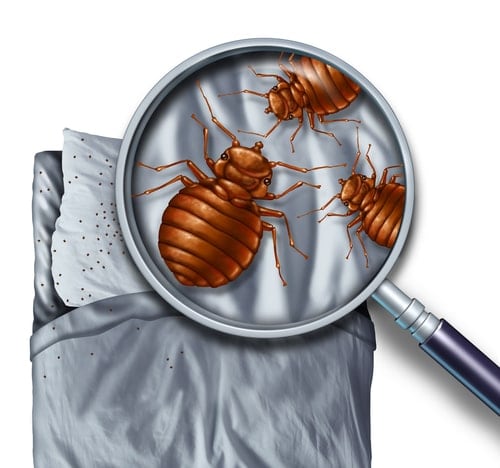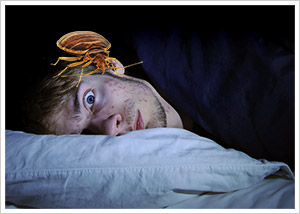Bed bugs are making a strong comeback in Toronto in recent years so it is important to get your facts straight about these pests to handle them accordingly. If you come in contact with bed bugs it can be very difficult to get rid of them as they are great at hiding and reproduce at enormous rates.
There are many myths circulating about bed bugs and if you fall into the trap of believing in these it could potentially worsen your bed bug experience. If you ever come into contact with these critters in your home make sure to contact your local bed bug exterminator right away.
Below are some of the most common bed bug myths around that may lead you to making poor decisions in dealing with the problem.
#1 Bed bugs are only found in low income neighbourhoods
This is probably the most popular myth circulating about bed bugs and is completely false. Bed bugs are not picky about where they live, the only requirement that they have is to be near a food source. They spread from one place to another either by coming in contact with new hosts or by creeping through cracks in apartment walls.

It is likely that there are more bed bug infestations in low income neighbourhoods due to the high cost of exterminating them, however, bed bugs are found in neighbourhoods of all social classes. Don’t be fooled and think that you are exempt from an infestation if you live in a classy neighbourhood.
#2 The Canadian weather is too severe for bed bugs to survive
Bed bugs are found in countries all around the world with varying temperatures. They can withstand a temperature range between -18° all the way up to 48° without dying. In order for them to die in cold temperatures they need to be exposed to it for an extended amount of time. Considering that they live in homes and apartments for the most part, the severe winter cold is usually not a factor for them.
#3 Bed bugs are invisible to the naked eye
It’s true that they are tiny pests, but not so tiny that you won’t be able to spot one running across your mattress. Adult bed bugs range in length from 3mm upto 5mm with a reddish brown colour. They are approximately the same shape and size of an apple seed and can be easily spotted with the naked eye. Even infant bed bugs, who are approximately 1mm in length, can be easily spotted with the naked eye. The reason people believe they are invisible to the naked eye is that they are great at hiding in small spaces during the day, thus very difficult to detect. They mainly come out at night while you are sleeping to feed on your blood.

Despite their reputation for moving about your house going unnoticed, there are some things you can do to increase your chances of catching them in action. To learn the top tips for finding bed bugs in your home check out this article.
#4 To get rid of bed bugs, get rid of your bed
Although their name suggests that they live inside your bed, this is not the only place that bed bugs hide. Bed bugs are thigmotrophic insects meaning that they like to hide in places where their body is in direct contact with its surrounding surfaces. As a result, bed bugs can be found in several small hiding spots around the home, and near its host such as in cracks and crevices, behind baseboards and wallpaper, in electronics, clothing and other furniture seams. They are also known to hide in other temporary hiding spots where they can attach to new hosts such as in buses, trains and cars.
#5 You can only get bed bugs if you have recently travelled
Your risk of attracting bed bugs is definitely higher when travelling, however, this is by no means the only way to get them. While travelling you stay in hotels and other dwellings that many people before you stayed in so you do risk a higher chance of contracting them, but you can also come in contact with them in your own city when taking public transit or going to a friends home who has an infestation. Your house can also become infested if you have a neighbour with an infestation and the bugs slowly make their way over to your home through cracks in the wall.

#6 Bed bugs have developed a resistance to all pesticides
Over the years bed bugs have been increasingly becoming resistant to overused pesticides such as DDT, however, they are not resistant to all pesticides. There are several different pesticides that can be used to eliminate bed bugs, along with some non chemical solutions such as heat treatment. It is best to hire a licensed pest exterminator to determine which method will be best to eliminate your specific bed bug infestation.
#7 Bed bug bites affect everyone in the same way

An obvious sign that you have been infested by bed bugs is waking up with their signature red bite marks on your body. You may wake up with irritated skin, red welts and even swelling the day after being bitten by bed bugs, but some people get little or no reaction at all to these critters.
If you are one of the lucky people who does not get a reaction from bed bugs, some other sure signs of an infestation are bed bug feces on your bed or small blood stains on your sheets. If you notice any of these signs it’s time to start searching for the critters and calling in a pest control company to do a thorough investigation.
#8 Bed bugs can fly
Bed bugs are quick little insects that can crawl at a pace of approximately 3 feet per minute but luckily they lack the ability to fly. Although bed bugs do have front wings on their body, these are vestigial wings and do not function for flying. If anything they act as an added layer of protection to their body but nothing more than that.
#9 Over the counter bed bug treatments are 100% effective
Over the years there have been many people claiming to have remedies to get rid of bed bugs and some of these have even made it to our store shelves. Bed bugs are extremely difficult to locate and completely eliminate from your home so this task should be left to professionals. The best advice for getting rid of bed bugs is to hire a licensed bed bug exterminator and follow their instructions.
#10 Bed bugs only bite at night

Bed bugs are mainly active at night, feeding on their hosts while they sleep, but they are also active during the day if an opportunity presents itself. It is still unknown how bed bugs navigate but one of the main hypotheses is that they detect pheromones released from our bodies when we sleep. If a bed bug is hungry and they sense we are sleeping during the day they will not hesitate to take the opportunity for a fresh blood meal.
#11 To avoid bed bugs, sleep in a metal bed
There is a common belief that if you make it difficult for bed bugs to hide in your bed by purchasing a metal bed frame you can avoid them. This is not true, as discussed above, because they have many more hiding spots than just your bed. If anything, replacing your bed with a metal one may cause the bed bugs to hide in more difficult to reach places, making the infestation harder to eliminate.
#12 Bed bug bites can make you ill

Luckily this myth is completely false. Although bugs that feed on your blood are often transmitters of disease, bed bugs have not been linked with the transmission of any diseases. Their bites can cause an irritation to your skin which can be itchy, especially for those who have an allergic reaction to the bites, but this is about the only physical harm they can do to you. The biggest concern with bed bugs is actually the psychological damage they can inflict on their hosts such as depression, anxiety, stress and sleep deprivation.
Final Thoughts
These are some of the most popular myths circulating about bed bugs, but keep in mind this is not a complete list. If you believe that you may have a bed bug infestation the best thing to do is become well informed on the topic. They can be very stressful to deal with and extremely difficult to get rid of and the longer you take to act, the worst that the problem will become. Do not believe what most people tell you, only listen to the advice of a professionally licensed pest control company to ensure proper measures are taken to get rid of your bed bug infestation.



